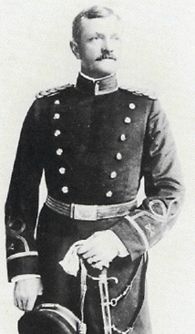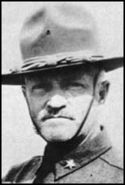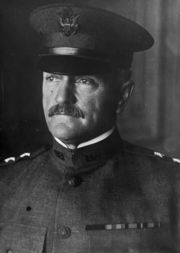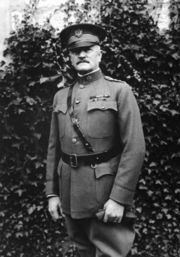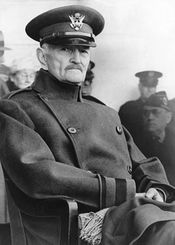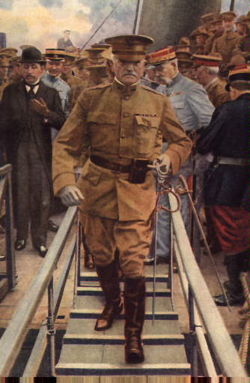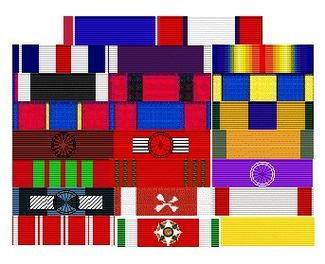John Pershing
2007 Schools Wikipedia Selection. Related subjects: Military People
| John J. Pershing | |
|---|---|
| September 13, 1860 - July 15, 1948 | |
 |
|
| Nickname | Black Jack |
| Place of birth | near Laclede, Missouri |
| Place of death | Washington, D.C. |
| Allegiance | United States Army |
| Years of service | 1886 - 1924 |
| Rank | General of the Armies |
| Commands | 8th Brigade American Expeditionary Force Army Chief of Staff |
| Battles/wars | Indian Wars Spanish American War Philippine American War World War I |
| Awards | Distinguished Service Cross Distinguished Service Medal Order of the Bath Légion d'honneur |
John Joseph "Black Jack" Pershing ( September 13, 1860 – July 15, 1948) was an officer in the United States Army. Pershing eventually rose to the highest rank ever held in the United States Army— General of the Armies—equivalent only to the posthumous rank of George Washington. Pershing led the American Expeditionary Force in World War I and was regarded as a mentor by the generation of American generals who led the United States army forces in Europe during World War II, including George C. Marshall, Dwight D. Eisenhower, Omar Bradley and George S. Patton, Jr.
Early life
John Joseph Pershing was born on September 13, 1860, on a farm near the town of Laclede, Missouri. John's father, John Fletcher Pershing was a local businessman who owned a general store in Laclede and moved his family into the town at the start of 1861. When the American Civil War began, John Fletcher Pershing worked as a sutler for the 18th Missouri Volunteer Infantry Regiment, but himself did not serve in the military nor participate in combat.
John J. Pershing attended a small school in Laclede that was seen as a "select school" and reserved for the more intelligent children who were sons and daughters of high profile citizens. As Pershing's father was a well known businessman in the Laclede area, both Pershing and his brother attended this early form of preparatory school.
Upon graduation from secondary school in 1878, Pershing became a local teacher and became involved with educating local African American children. In this way, although living in an atmosphere of 19th century United States racism, Pershing developed an understanding of racial tolerance that would later come to play in his military career when he commanded a racially diverse unit of soldiers.
Between 1880 and 1882, Pershing attended the First Missouri Normal School in Kirksville, Missouri, later Truman State University. In the spring of 1882, already twenty one years old, Pershing applied to the United States Military Academy after hearing that West Point offered an excellent college level education. Pershing would later admit to his sister that a desire to serve in the military was secondary to attending West Point and that he mainly applied to the school because the education offered was better than that of rural Missouri at that time.
West Point years
John J. Pershing was sworn in as a West Point Cadet in the fall of 1882. He was selected early for leadership and rose to become First Corporal, First Sergeant, First Lieutenant, and First Captain, the highest possible cadet rank at West Point. Ex Officio of his position, Cadet First Captain Pershing commanded the West Point Honour Guard that escorted the funeral of President Ulysses S. Grant.
Pershing graduated from West Point in the summer of 1886 and was commended by the Superintendent of West Point, General Merritt, as having high leadership skills and possessing "superb ability".
Just prior to graduation, Pershing briefly considered petitioning the Army to let him study law and delay his commission. He applied for a furlough from West Point, but soon withdrew the request in favour of active Army duty. He was commissioned a Second Lieutenant in the United States Army in the fall of 1886, at the age of twenty six, graduating thirtieth in a class of seventy seven from West Point. His father died on April 5, 1886. His mother passed a week and a half later, much to his dismay.
Early career
Pershing reported for active duty on September 30, 1886, and was assigned to Troop L of the 6th U.S. Cavalry stationed at Fort Bayard, New Mexico. While serving in the 6th Cavalry, Pershing participated in several Indian campaigns and was cited for bravery for actions against the Apache.
Between 1887 and 1890, Pershing served with the 6th Cavalry at various postings in California, Arizona, and North Dakota. He also became an expert marksman and, in 1891, was rated second in pistol and fifth in rifle out of all soldiers in the U.S. Army.
On December 9, 1890, Pershing and the 6th Cavalry arrived at Sioux City, Iowa where Pershing played a role in suppressing the last uprisings of the Lakota (Sioux) Indians. A year later, he was assigned as an instructor of military tactics at the University of Nebraska-Lincoln. Pershing would hold this posting until 1895, but was not promoted, remaining as a Second Lieutenant at the age of 35 years old.
While in Nebraska, Pershing also attended law school and graduated in 1893. Additionally, he formed a drill company in 1894 that won the Omaha Cup.
On October 1, 1895, Pershing was promoted to First Lieutenant and took command of a unit within the United States Army's 10th Cavalry Regiment (one of the original Buffalo Soldier regiments), which was comprised of African-American soldiers under white officers. From Fort Assiniboine in north central Montana, he commanded an expedition to the south and southwest that rounded up and deported a large number of Cree Indians to Canada. Though, like the rest of the nation at the time, he was unsympathetic to Native Americans, Pershing was an outspoken advocate of the value of African American soldiers in the U.S. military.
In 1897, Pershing became an instructor at West Point where he joined the tactical staff. While at West Point, cadets upset over Pershing's harsh treatment and high standards took to calling him "Nigger Jack" as a reference to his service with the 10th Cavalry. This was softened to "Black Jack" by reporters covering Pershing during World War I.
Spanish and Philippine-American wars
Upon the outbreak of the Spanish-American War, First Lieutenant Pershing (now 38 years old) was offered a brevet rank and was commissioned a Major of Volunteers on August 26, 1898. He fought with distinction at Kettle and San Juan Hill in Cuba and was cited for gallantry. In 1919, he was awarded the Silver Citation Star for these actions and, in 1932, the award was upgraded to the Silver Star Medal.
In March 1899, after suffering from malaria and spending a sick furlough in the United States, Pershing was put in charge of the Office of Customs and Insular Affairs which oversaw occupation forces in territories gained in the Spanish-American War, to include Cuba, Puerto Rico, the Philippines, and Guam.
When the Philippine-American War broke out, Pershing was ordered to Manila and reported for duty on August 17, 1899. He was assigned to the Department of Mindanao and Jolo and commanded efforts to suppress the Philippine rebellion. On November 27, 1900, Pershing was appointed Adjutant General of his Department and served in this posting until March 1, 1901. He was cited for bravery for actions on the Cagayan River while attempting to destroy a rebel stronghold at Macajambo.
In the spring of 1901, Pershing's brevet commission was revoked and he was recommissioned as a Captain in the Regular Army. He served with the U.S. 1st Cavalry Regiment in the Philippines, continuing actions against Philippine rebels. He later joined the U.S. 15th Cavalry Regiment where he served as Intelligence Officer, participating in actions against the Moros, where he was cited for bravery at Lake Lanao. In June 1901, he also briefly served as Commander of Camp Vicars, Philippines, after the previous camp commander had been promoted to Brigadier General.
Rise to General
In June 1903, Pershing was ordered to return to the United States. He was forty-three years old and still a Captain in the U.S. Army. President Theodore Roosevelt petitioned the Army General Staff to promote Pershing to Colonel, but Pershing's superiors declined the notion and also would not consider a promotion to Lieutenant Colonel or even Major. This angered Roosevelt, but since the President could only promote Army officers in the General ranks, his hands were tied.
In 1904, Pershing was assigned as the Assistant Chief of Staff of the Southwest Army Division stationed at Oklahoma City, Oklahoma. In October 1904, he attended the Army War College and then was ordered to Washington, DC for "general duties unassigned".
Since Theodore Roosevelt could not yet promote Pershing, he petitioned the United States Congress to authorize a diplomatic posting and Pershing was stationed as military attaché in Tokyo in 1905. Also, in 1905, Pershing married the daughter of powerful U.S. Senator Francis E. Warren, a Wyoming Republican. The union greatly helped his military career.
After serving as an observer in the Russo-Japanese War, Pershing returned to the United States in the fall of 1905, now forty-five years old. In a move that shocked the Army establishment, President Theodore Roosevelt convinced Congress to authorize the appointment of Pershing as a Brigadier General in the United States Army, thus skipping three ranks. This promotion outraged several high ranking Army officers who would state, for the rest of their careers, that Pershing's appointment was the result of political connections and not military abilities.
In 1908, Pershing briefly served as a U.S. military observer in the Balkans, an assignment which was based out of Paris. Upon returning the United States, at the end of 1909, Pershing was assigned once again to the Philippines, an assignment which he served until 1912. While in the Philippines, he served as Commander of Fort McKinley, near Manila, and also was the governor of the Moro Province. The last of Pershing's four children was born in the Philippines and it was during this time that he became an Episcopalian.
Pancho Villa and the Mexican Revolution
In January 1914, Pershing was assigned to command the Army 8th Brigade in Fort Bliss, Texas, responsible for security along the U.S.-Mexico border. In March 1915, under the command of General Frederick Funston, Pershing led the 8th Brigade on the failed 1916–17 Punitive Expedition into Mexico in search of the outlaw Pancho Villa. General Pershing was assigned a 1915 Dodge Brothers touring car, serial number 3066. During this time, George S. Patton served as one of Pershing's aides.
After a year at Fort Bliss, Pershing decided to bring his family there. The arrangements were almost complete, when on the morning of August 27, 1915, he received a telegram telling him of a fire in the Presidio of San Francisco. His wife and three young daughters were burned to death in a house fire, only his six-year-old son Warren was saved. Many who knew Pershing said he never recovered from the deaths of his wife and daughters. After the funerals at Lakeview Cemetery in Cheyenne, Wyoming, Pershing returned to Fort Bliss with his son, Warren, and his sister Mae, and resumed his duties of commanding officer.
World War I
In 1917, following America's entrance into World War I, President Woodrow Wilson named Pershing to command the American Expeditionary Forces, a post which he retained until 1918. Pershing was responsible for the organization, training, and supply of an inexperienced force that eventually grew from 27,000 men to over two million soldiers. In this way, Pershing is credited with the creation of the " National Army", a combined draft and professional Army force that was called upon to fight World War I.
Pershing was appointed a Major General in the National Army and his force deployed to Europe. Upon arriving in France, Pershing fought continual political campaigns to keep the AEF from being split up to augment British and French forces. During this time, George C. Marshall served as one of Pershing's assistants and Douglas MacArthur was one of his Division Commanders. His chief of staff was James Harbord, who would work as Pershing's closest assistant through the years and remain extremely loyal to Pershing.
In 1918, Pershing was commissioned as a full General and led the United States' forces in Europe. While in Europe, Pershing openly scorned the slow trench warfare of the previous three years on the Western Front, believing that to fight over a small area of no-man's land was very costly and senseless. Under his command, the American Expeditionary Force developed advanced mobile warfare, relying on direct assaults on enemy positions, as well as close-quarter shelling of targets.
The AEF's offensives at Meuse-Argonne and Saint-Mihiel in France were largely responsible for hastening the Allied victory and the German armistice; these successes were largely credited to Pershing, and he became the most celebrated American leader of the war. Critics, however, would claim that Pershing commanded from far behind the lines and was critical of commanders who personally led troops into battle. This would become a hard point with Douglas MacArthur, who saw Pershing as a desk soldier and a negative relationship between the two men had developed by the end of the war.
Later career
In 1919, in recognition of his distinguished service during World War I, the US Congress authorized the President to promote Pershing to General of the Armies of the United States, a rank created especially for him and one that only he held at the time (Lieutenant General George Washington was posthumously promoted to this rank by President Gerald Ford in 1976). Pershing was authorized to create his insignia for the new rank but declined, wearing the four stars of a regular General for the rest of his career.
There was a movement to make Pershing President of the United States in 1920, but he refused to actively campaign. In a newspaper article, he said that he "wouldn't decline to serve" if the people wanted him and this made front page headlines. Though Pershing was a Republican, many of his party's leaders considered him too closely tied to the policies of the Democratic Party's President Wilson. The Republican nomination went to Senator Warren G. Harding of Ohio, who won the 1920 presidential election.
In 1921, Pershing became Chief of Staff of the United States Army, serving at this posting for three years. He created the Pershing Map. In 1924, now sixty four years old, Pershing retired from active military service, yet continued to be listed on the active duty rolls as part of his commission as General of the Armies.
On November 1, 1921 Pershing was in Kansas City to take part in the groundbreaking ceremony for the Liberty Memorial that was being constructed there. Also present that day were Lieutenant General Baron Jacques of Belgium, Admiral David Beatty of Great Britain, Marshal Ferdinand Foch of France and General Armando Diaz of Italy. One of the main speakers was Vice President Calvin Coolidge of the United States. In 1935 bas-reliefs of Pershing, Jacques, Foch and Diaz by sculptor Walker Hancock were added to the memorial.
During the 1930s, Pershing maintained a private life, but was made famous by his memoirs, My Experiences in the World War, which were awarded the 1932 Pulitzer Prize for history.
In 1940, Pershing was an outspoken advocate of aid for the United Kingdom during World War II. In 1944, with the creation of the new five star rank General of the Army, Pershing was acknowledged as the highest ranking officer of the United States military. When asked if this made Pershing a Six Star General, the then Secretary of War ( Henry L. Stimson) commented that it did not, since Pershing never wore more than four stars but that Pershing was still to be considered senior to the present five star Generals of World War II.
Pershing lived through the entirety of World War II to see America's victory. On July 15, 1948, he died and was buried in Arlington National Cemetery, near the gravesites of the soldiers he commanded in Europe, after a state funeral.
Summary of Service
Dates of Rank
- August 1886: Second Lieutenant, United States Army
- October 1892: First Lieutenant, United States Army
- August 1898: Brevet Major of Volunteers, U.S. Army
- June 1901: Captain, U.S. Army (reverted to permanent rank)
- September 1906: Brigadier General, United States Army
- May 1916: Major General, United States Army
- October 1917: General, National Army
- September 1919: General of the Armies of the United States
Assignment History
- 1882: Cadet, United States Military Academy
- 1886: Troop L, Sixth Cavalry
- 1891: Professor of Tactics, University of Nebraska-Lincoln
- 1895: Commanding Officer, 10th Cavalry Regiment
- 1897: Instructor, United States Military Academy, West Point
- 1898: Major of Volunteer Forces, Cuban Campaign, Spanish-American War
- 1899: Officer-in-Charge, Office of Customs and Insular Affairs
- 1900: Adjutant General, Department of Mindanao and Jolo, Philippines
- 1901: Battalion Officer, 1st Cavalry and Intelligence Officer, 15th Cavalry (Philippines)
- 1902: Officer-in-Charge, Camp Vicars, Philippines
- 1904: Assistant Chief of Staff, Southwest Army Division, Oklahoma
- 1905: Military attaché, U.S. Embassy, Tokyo, Japan
- 1908: Military Advisor to American Embassy, France
- 1909: Commander of Fort McKinley, Manila, and governor of Moro Province
- 1914: Brigade Commander, 8th Army Brigade
- 1916: Commanding General, Mexican Punitive Expedition
- 1917: Commanding General for the formation of the National Army
- 1918: Commanding General, American Expeditionary Forces, Europe
- 1921: Chief of Staff of the United States Army
- 1924: Retired from active military service
- 1925: Chief Commissioner assigned by the United States in the arbitration case for the provinces of Tacna and Arica between Peru and Chile.
Awards and decorations
United States decorations
- Distinguished Service Cross
- Distinguished Service Medal
- World War I Victory Medal (with 15 battle clasps)
- Indian Campaign Medal
- Spanish Campaign Medal (with Silver Citation Star)
- Army of Cuban Occupation Medal
- Philippine Campaign Medal
- Mexican Service Medal
In 1932, seven years after Pershing's retirement from active service, his silver citation star was upgraded to the Silver Star Medal and he became eligible for the Purple Heart. In 1941, he was retroactively awarded the Army of Occupation of Germany Medal for service in Germany following the close of World War I.
Foreign and international awards
- Knight Grand Cross of the Order of the Bath ( Britain)
- Grand Cross of the Legion of Honour (France)
- Military Medal (France)
- Croix de Guerre with Palm (France)
- Grand Cross of the Order of Leopold (Belgium)
- Croix de Guerre (Belgium)
- Virtuti Militari (Poland)
- Order of the White Lion (1st Class with Sword) ( Czechoslovakia)
- Czechoslovakian War Cross
- Grand Cordon of the Order of the Precious Jade (China)
- Order of the Golden Grain (1st Class) (China)
- Order of the Redeemer (Greece)
- Grand Cross of the Military Order of Savoy (Italy)
- Grand Cross of the Order of Saints Maurice and Lazarus (Italy)
- Order of the Rising Sun (Japan)
- Medaille Obilitch (Montenegro)
- Grand Cross of the Order of Prince Danilo I (Montenegro)
- Medal of La Solidaridad (1st Class) (Panama)
- Grand Cross of the Order of the Sun (Peru)
- Order of Michael the Brave (1st Class) (Romania)
- Grand Cordon of the Order of the Liberator (Venezuela)
- Grand Cross of the Order of Karadjordje with Swords (Serbia)
Civilian awards
- Congressional Gold Medal of Honour
- Thanks of the United States Congress
- Special Medal of the Committee of the city of Buenos Aires
Other Honours
- Pershing Park in Washington D.C. features the Pershing Memorial.
- The Great Pershing Balloon Derby at Brookfield, Missouri is named in his honour and is held over the Labor Day weekend each year.
- The John J. Pershing Military and Naval Science Building on the campus of the University of Nebraska–Lincoln.
- At Truman State University, he is the namesake of the Pershing Society, Pershing Hall, Pershing Arena and the Pershing Scholarships.
- There is a Pershing Hall named in his honour at his alma mater, the United States Military Academy at West Point.
- In honour of Pershing's service to his country, the Pershing tank and Pershing missile were later named after him.
- The 2nd Brigade of the U.S. 1st Cavalry Division is nicknamed "Black Jack".
- Pershing County, in the state of Nevada, is named in his honour.
- Chicago, Burlington and Quincy Railroad named a diesel engined streamliner train after him in 1939 known as the General Pershing Zephyr.
- Various streets, civic center, schools and towns are today named in honour of John J. Pershing.
- A riderless horse was named in honour of Pershing, " Black Jack."
- Plaza Pershing was established in Zamboanga City, Philippines to honour him with his victory over Muslim insurgents.
Trivia
- General Pershing's grandson, 2nd Lieutenant Richard W. Pershing, was killed in action on the 17 February 1968 whilst serving in the 502nd Infantry during the Vietnam War.

